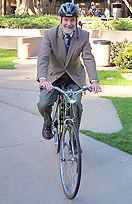News
Parking expert Shoup is Clarkson Chair
Donald Shoup, a widely published and influential professor of urban planning at the University of California-Los Angeles, has been named the 2010 Clarkson Visiting Chair in Urban and Regional Planning in the School of Architecture and Planning.
Shoup’s extensive research into parking as a key link between transportation and land use has had important consequences for cities, the economy and the environment.
He will be scholar-in-residence in the architecture school Jan. 25-29, during which time he will teach and present a series of public lectures and seminars on and off campus for both academicians and local planning practitioners.
Among them is the 2010 Clarkson Lecture, which will be held at 5:30 p.m. Jan. 27 in 301 Crosby Hall, South Campus. It will be free and open to the public
Shoup is the author of “The High Cost of Free Parking” (2005), a 773-page tour de force in which he argues against the large consumption of land and other resources in urban and suburban areas for motor vehicle parking.
Free parking, he argued, has contributed to auto dependence, rapid urban sprawl and bad urban design, and distorts transportation choices, promotes extravagant energy use, hurts the economy, damages the environment and provokes a host of other problems.
The book popularized market-rate parking and performance parking, both of which raise the price of metered street parking with the goal of reducing cruising for parking and double parking. It has led many cities to reduce or remove off-street parking requirements, and to charge fair market prices for curb parking and dedicate the resulting revenue to finance public services in districts that generate that revenue.
Shoup’s research on employer-paid parking, published as “Parking Cash Out” (2005), led to passage of California’s parking cash-out law, which requires certain employers who provide subsidized parking for their employees to offer a cash allowance in lieu of a parking space, and to changes in the Internal Revenue Code to encourage parking cash out.
A fellow of the American Institute of Certified Planners, Shoup has been a visiting scholar at Cambridge University and the World Bank, and has served as director of the Institute of Transportation Studies and chair of the Department of Urban Planning at UCLA.
He holds a BE in electrical engineering and a BA, MA and PhD in economics, all from from Yale University.
The Clarkson Visiting Chair is an endowed visiting position awarded to distinguished scholars or professionals in the disciplines of architecture and urban planning. It recognizes excellence in the pursuit of scholarship and professional application within these disciplines and is made possible by the generous support of Will and Nan Clarkson.


Reader Comments
Michael Tyson says:
I have driven across this country many times over, and one of the ugliest sights I see from city to city is the profusion of massive parking lots for retail in suburban areas. To counter the argument that paid parking downtown contributes to sprawl, consider what would happen if the suburban parking lots were required to charge as well. My only caveat is that, in a city like Buffalo, I would want revamped public transit if I am expected to leave my car at home and for at least three months of the year riding a bicycle is rather unrealistic.
Posted by Michael Tyson, Student, 01/16/10
Jim Campbell says:
The benefit of free parking is a great freedom of movement. This should not be ignored or discounted. It is itself an important and liberating benefit and it has huge economic benefits. Downtown business districts have been crushed over time by the failure to provide for free public parking. This has contributed to the sprawl that these planners often deride. Those who ask others to take the bus or bike are fundamentally unrealistic. A few parking lots are far preferable to huge subsidies to bring businesses back into urban areas (Bass Pro anyone?) or the urban blight that is left in abandoned downtowns districts.
Posted by Jim Campbell, Professor, 01/14/10